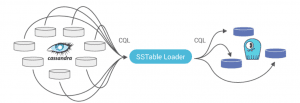Apache Cassandra may have served you well. But alas, nothing is ever perfect, so you’re looking to migrate. Typically sub-millisecond consistency, performance of various operations, compaction, as well as read/write latency (especially under heavy loads) can be less than optimal.
You have probably heard that Scylla is a drop-in replacement for Apache Cassandra. Given the 10x performance increase with improved latency, and with zero downtime for the migration process, who wouldn’t want to try it out?
You’ve tried it out, but how do you actually migrate from Apache Cassandra to Scylla? To help you through the process, we created our Apache Cassandra to Scylla Migration Process documentation.
There are four phases in the migration process once you’ve created your Apache Cassandra schemas in Scylla:
- Dual writes: updating application logic to write to both databases:
![migrate]()
- Forklifting: migrating historical data (SSTables) from Apache Cassandra to Scylla using sstableloader:
![Phase 2: Forklifting - sstables loaded to Scylla with sstableloader]()
- Dual reads: validating ongoing data sync between the two DBs:
![Phase 3: Dual reads- validating ongoing data sync between the two DBs]()
- Phase out: The final phase takes place as the old Apache Cassandra database is phased out. After this point, all reads and writes go via the new Scylla instance.
The detailed steps and timeline can be found in our migration docs.
Before you migrate, learn more!
Learn about consistency levels with our console demo. Read about our architecture, and see how easy it is to get started with Scylla. Check out Scylla for administrators, learn Scylla for developers, model your own CQL, browse our FAQ and knowledge base and learn how to contribute to Scylla.
Of course, you can see these and related concepts in action with a download of Scylla or on Docker Hub. You can also take a test drive and put Scylla through a live performance test.
The post New Docs: 4 Phases to Migrate from Apache Cassandra to Scylla appeared first on ScyllaDB.


